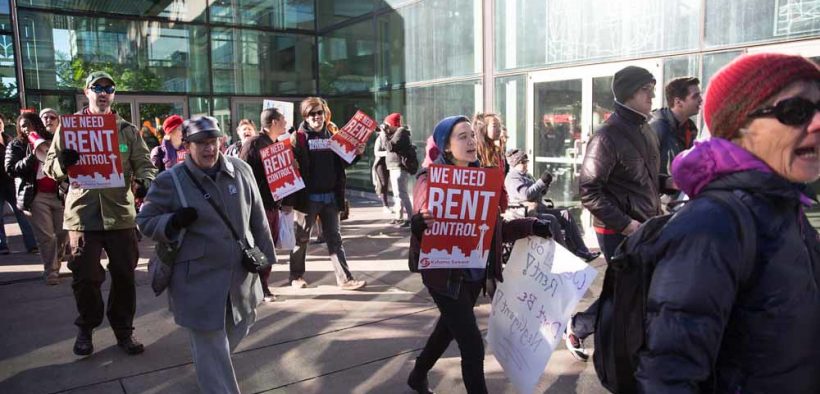Study Proves Landlords Exploit the Poor

Researchers found that the exploitation rates of black neighborhoods are nearly double that of other neighborhoods.
Two researchers, MIT’s Nathan Wilmers and Princeton’s Matthew Desmond, decide to study the exploitation of the poor by looking at rent burdens in low-income neighborhoods and the high profit margins landlords in such areas make. The two authors recently published their findings in a detailed article in the American Journal of Sociology.
To gather the information, the researchers surveyed a variety of housing market data, focusing on the housing market in Milwaukee and comparing it to a nationwide dataset. They concentrated on data such as property values, monthly rent, larger expenses like plumbing repairs, as well as other expenses, including property insurance, mortgage payments and routine maintenance costs.
What Is Rent Exploitation?

Photographs of the Rally to Restore Sanity and/or Fear. October, 2010. (Photo: David Shankbone)
The researchers centered their study on the idea of exploitation, which is typically associated with workers and the workplace. The dictionary definition of exploit is “to make use of meanly or unfairly for one’s own advantage.”
According to Karl Marx’s famous theory, capitalists made their profits by exploiting working class people. Desmond and Wilmers cite the late Marxist sociologist Erik Olin Wright’s definition of exploitation. According to Wright, exploitation “occurs when the material welfare of one class is causally dependent upon the material deprivation of another.”
Essentially, exploitation occurs when an individual or group excludes another from a resource to enrich itself. The resource, in this case, is housing. The researchers call this notion “exploitation rates,” in other words, the percentage of a particular property’s worth that the renters pay each month.
What Are Typical Landlord Profit Margins?
Nationwide, landlords average almost $100 per unit in net profit in poor neighborhoods, about $50 in affluent areas and only $3 in middle-class neighborhoods. In Milwaukee, the profits are even higher. Here, landlords take home an average of $150 per unit in poor neighborhoods, and approximately $20 in other areas.
In cities that have a higher cost of living, such as San Francisco and New York, landlords make money through gentrification and appreciation. In less expensive cities such as Milwaukee, the profit rates increase with the poverty rates.
In high-poverty areas, where 50% to 60% of the people live in poverty, the exploitation rate is 25%. This means that in just one year of rent, 25% of the property value is paid back. In neighborhoods that have poverty rates lower than 15%, the exploitation rate is only 10%.
As the ratio of rent to property value increases, the level of exploitation increases. Interestingly, the researchers found that the exploitation rates of black neighborhoods are nearly double that of other neighborhoods, 20% to 25% compared to 10% to 15%, respectively.
Why Do Poor Neighborhoods Generate More Money?
Desmond and Wilmers contend that poor neighborhoods have been a “prime moneymaker” for a long time, benefiting people who profit from racial segregation, land scarcity and deferred maintenance. Viewing “slums” as a “byproduct of the modern city” or unkempt areas that accidentally happen over time is an error, they argue.
They write, “If labor exploitation is understood to be getting paid less than the market value of what one produces, we can extend this definition to the housing market by operationalizing exploitation as being overcharged relative to the market value of what one purchases, paying more for less.”
Since housing in poorer neighborhoods often comes with a higher risk than other properties, landlords often charge higher rent. These older, less valuable buildings are more likely to be in poor condition, and landlords sometimes worry about not receiving payment from people in low-income housing.
The researchers found that repairs were needed more frequently in buildings that were in poor neighborhoods, and the tenants did sometimes miss payments. However, the profits of landlords were still higher. The average profit of landlords in Milwaukee was $151 each month per unit, as opposed to an average of $21 per unit in wealthier neighborhoods.
According to Big Think, “Because landlords operating in poor communities cannot know with certainty whether a new tenant will cost them money, they may attempt to mitigate that risk by raising the rents of all their tenants, carrying the weight of social structure into price. Poor renters pay double—purchasing the good and the risk—but because losses remain infrequent in absolute terms, landlords typically realize the surplus ‘risk charge’ as higher profits.”
Landlords depend on the higher income they receive from low-income tenants offsetting the lower income they acquire from more affluent properties.
Desmond and Wilmers conclude, “[L]andlords who have invested in a nonpoor neighborhood are not betting on today but on tomorrow. In poor neighborhoods, however, landlords are betting on today.” They continue to say that “money made slums because slums make money.”
People who live in poor neighborhoods typically have no other options. Unfortunately, they must continually face exploitation, rather than encounter the possibility of homelessness.







